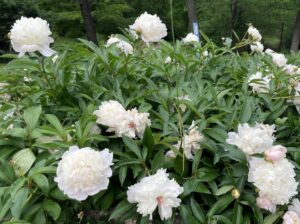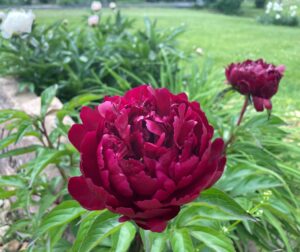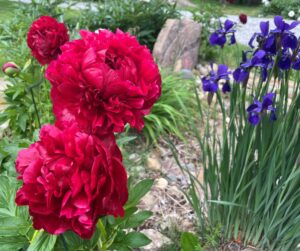Peonies are a common and favored landscape plant in Indiana. Despite their famed attribute of being easy to care for, some annual upkeep will ensure peonies continue to beautifully bloom year after year.
Depending on the species and cultivar, peonies will bloom from late spring to early summer. Peonies were traditionally white, blush, pink, and red in color. However, due to breeding, coral, yellow, and patterned peonies can now be found. In addition to a wide variety of colors, blooms also come in a variety of different shapes. Planting a variety of peonies will extend bloom time and enjoyment.
Best time to plant is early fall. Purchase rot free divisions containing 3-4 buds (eyes) and ensure the eyes of the peony aren’t more than 2 inches under the soil line. Smaller divisions may take longer to begin blooming. Peonies fare best in full sun but will tolerate some light shade. Peonies require winter cold to flower so don’t mulch over the winter. Peonies need ample space as flower size can decrease with competition from nearby trees and shrubs; Mulch peonies each spring with 2 – 3 inches of material to control weeds. Over-fertilizing can also reduce the bloom of your peonies. Too much nitrogen fertilizer will cause the plants to produce a lot of foliage and reduce the number of blooms. Established plants with good growth only need to be fertilized every few years. When fertilizing, do so after they are done blooming and use a balanced fertilizer or one with a higher phosphorous content (middle number). Never apply fertilizer directly on the center as the buds may be damaged. Rather, place the fertilizer in a band from 8 to 18 inches from the center of the plant. Water the fertilizer in.
After blooming, it’s a good idea to remove flower heads and/or seed pods. This will help the appearance of the plants and also prevent the plant from sending energy into producing seeds. Despite the old wives’ tale, peonies do not need ants to help them flower. Ants are commonly seen on the buds of peonies because of the extrafloral nectaries on their sepals (leaf-like structures that cover the flower before it opens).
Familiarize yourself with symptoms of common peony diseases such as leaf blotch, powdery mildew, and different blights. Take action early to safeguard plant vigor.
In the fall, cut peony foliage back to the ground. Compost or discard foliage. This aids in keeping disease development down. Divide and replant only after they become crowded — usually after 10 to 15 years. Carefully dig under the plant to avoid cutting off roots, cut tubers (with 3-5 eyes) with a sharp sterilized knife. Dust cut surfaces with fungicide to discourage disease infection and rot.


